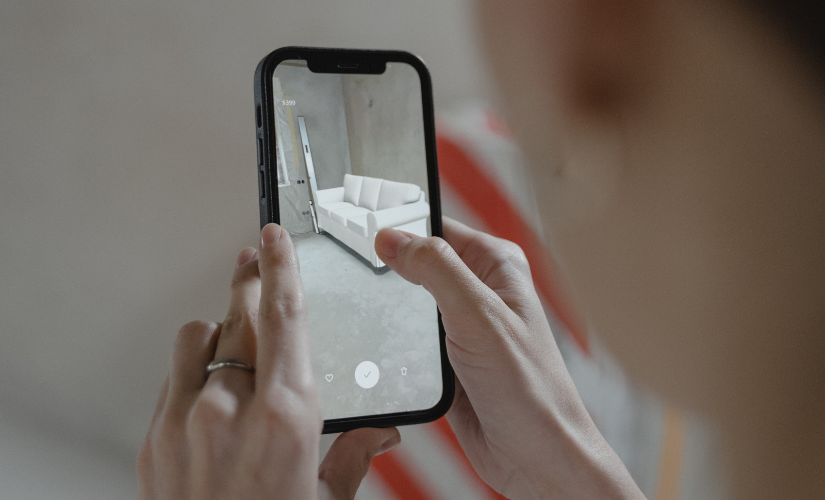Using Augmented Reality to Level up your E-Commerce Business
With 20.8% of all retail transactions occurring online in 2023, technological advancements are the driving force behind how customers shop. […] The post Using Augmented Reality to Level up your E-Commerce Business appeared first on ReadWrite.

With 20.8% of all retail transactions occurring online in 2023, technological advancements are the driving force behind how customers shop. In today’s dynamic landscape, everything is rapidly evolving, from how we browse through our favorite stores to how we purchase something, and Augmented Reality is one of them.
Since customer preferences are ever-changing, businesses seek new ways to captivate their audience. Integrating augmented reality (AR) into ecommerce experiences is just one of these ways.
Related: Evolution of Ecommerce – A Glimpse of Its Past, Present, and Future
Augmented Reality in Ecommerce
Augmented reality is an innovative technology that helps sync digital elements with the real world, providing an immersive experience for customers. Leveraging AR is proving to be a game changer for several businesses, transforming the way their customers interact with their products and services.
Augmented reality first gained prominence through entertainment apps like Pokémon Go and is now slowly progressing onto the e-commerce stage. According to industry experts and market analysts, AR will soon become a cornerstone of e-commerce success. A Statista forecast survey reveals that by 2025, around one-third of shoppers in the United States will have used AI-powered technologies when buying products online.
So, if you’re ready to hop on board the AR hype train, let’s review some of its benefits to your business.
Better customer engagement
A lot of businesses hesitate to incorporate AR technology into their business strategies. Mostly, they think it’s just a gimmick or a fad that will die soon. But I can assure you it’s not and will not fade away soon. According to a Deloitte report, by 2025, roughly 4.3 billion global consumers will use AR technology frequently.
Harnessing the power of AR will allow you to engage your customers better and attract other potential customers as well. A survey conducted by Retail Perceptions revealed that 71% of customers would be more willing to frequent retailers that offer augmented reality experiences. This engagement isn’t just temporary; it translates directly into conversions and long-term brand loyalty.
By creating immersive shopping experiences to captivate their audience, brands can leverage AR to bring interactivity and engagement to their campaigns that couldn’t have been done previously using traditional marketing methods.
Personalized shopping experience
‘Personalization’ is the buzzword on everyone’s lips these days. Customers want their shopping experience to feel unique and tailored to their needs. AR helps elevate a mundane and generic shopping experience to a personalized one for every customer.
Augmented reality can do this by curating product recommendations based on individual preferences, behaviors, and shopping habits. McKinsey research shows that 71 percent of customers expect brands to deliver personalized shopping experiences, and not only that, but 76 percent of them actually get frustrated when this doesn’t happen.
This makes AR more of a necessity than it was before. And it’s a win-win situation for both the business and the customers. By seamlessly merging the digital and physical realms, AR offers a unique opportunity to create bespoke shopping journeys that resonate with customers.
Related: How Augmented Reality (AR) Continues to Transform Customer Experience?
Improved product visualization
AR actually addresses a common pain point that many online shoppers face – visualizing how the product would fit you or look on you. The frustration of buying a product only to find it doesn’t quite fit or look as good on you as you thought it would is an all-too-common scenario. Time suggests that people return almost 40% of what they buy online due to sizing issues.
Being able to visualize how you would look like in a particular dress or wearing a shade of lipstick that looks really good can save a lot of time and money for both customers and retailers alike. AR helps turn their imagination into reality by enabling customers to visualize products in their real-world environments before purchasing.
Shopify’s research indicates that retailers who add 3D and AR content to their stores experience an impressive 94% increase in conversion rates. A lot of it has to do with customers being assured of what they’re buying. AR can significantly reduce the uncertainty associated with online purchases.
Success Stories of Brands Leveraging Augmented Reality
Augmented reality isn’t exactly new on the market, and several brands have recognized its transformative potential and used it to curate immersive experiences for their customers. Let’s look at some prominent ones.
NikeFit
Nike has recognized a vital pain point their customers face: the inability always to purchase the correct size when buying shoes online. According to them, three out of five people are probably wearing the wrong shoe size. To address this concern, they’ve developed NikeFit – a mobile app made using AR technology that scans customers’ feet to determine their correct shoe size. Using this, customers can ensure they purchase the right size and don’t face any hassles when exchanging or returning the shoes.
L’Oreal Virtual Makeup and Hair Color Try-On
A common issue many women experience when purchasing makeup products or hair colors is that they look great in ads or other women, but they don’t end up looking as good on them as they thought. L’Oreal has come up with an intelligent solution for this with the help of AR technology. They have created a virtual try-on experience for all their products on their website and app. So now customers can see how a shade of lipstick or a particular hair color will look on them before purchasing it. This proved to be a really effective strategy, with L’Oreal’s ecommerce sales increasing by a massive 49% following the unveiling of the technology.
IKEA Place
Home furnishings giant IKEA didn’t fall behind in the race to adopt AR for continued success. The launch of their innovative app, IKEA Place, ushered in a new era of visualization for home decor. Imagine having the ability to see how the rustic armchair fits in your living room.
Picture-checking if the stylish coffee table goes well with your current interior design. The app turns these visualizations into reality. It uses augmented reality technology to achieve this. The app lets users place 3D models of IKEA’s products virtually in their living spaces. This is done using the camera on their smartphones. The 3D models are true-to-scale representations of the actual products.
This helps customers make a buying decision and decide whether to go through with the purchase or not.
Implementing Augmented Reality in Your Ecommerce Strategy
According to Mobile Marketer, 52% of online retailers are not yet ready to integrate AR technology into their shopping experiences. Venturing into a new realm of technology, especially one that can be as overwhelming as AR, is indeed daunting. But its benefits to your business will ultimately be worth it.
So, before you embark on your AR integration journey, it’s imperative to keep a few things in mind.
Understand your target audience
All your efforts and money will go in vain if you don’t understand your target audience’s preferences and technological familiarity. Different age groups have varying degrees of comfort with technology. For instance, Millennials and Gen Z, having grown up in the digital age, are more likely to embrace AR experiences compared to their predecessors.
Choose the right AR technology
The AR technology you decide to adopt depends on the outcomes you hope to achieve. If you’re considering using AR to offer product information, you can choose marker-based AR. This method requires scanning markers to display digital content. In contrast, markerless AR identifies real-world surfaces and objects, which is particularly useful for creating virtual try-on opportunities.
Collaborate with AR developers
While the idea of integrating AR into your e-commerce platform is exciting, it is also something that requires expert consultation and effort. Collaborating with AR development experts can ensure a smooth implementation of AR technology into your ecommerce venture. Their expertise can mitigate technical challenges, ensuring optimal user experiences and seamless interactions.
Innovative content creation
Creating innovative and compelling content is the heart of any successful augmented reality campaign. AR’s potential for immersive experiences demands a strategic approach to content creation that resonates with your target audience. So you need to ensure that you create content that targets common difficulties your customers face and provides a prompt solution for them with the help of AR.
Related: Why You Should Use Augmented Reality in Your Business App
Challenges to Overcome When Integrating AR Technology
Integrating AR into your business’ ecommerce strategy is promising but comes with its fair share of challenges.
The problem of assuring a smooth user experience is paramount, and as the AR experience grows more sophisticated, so does the risk of encountering lag or latency. To combat this, it is crucial to strike a balance between real-time interaction and maintaining the fluidity of the technology.
In addition, technical barriers can also hamper your AR efforts. Device compatibility emerges as a prominent concern, as AR experiences need to be accessible across a variety of devices. Moreover, factors like internet speed and bandwidth can also affect the performance of AR applications. Dealing with these technical barriers involves optimizing applications for a range of devices. Moreover, a robust network infrastructure to support AR’s data-intensive demands.
Questions about privacy and data security are of the utmost concern for any user. AR apps often require access to personal data. This can cause concerns about data collection, storage, and potential misuse. Users need assurance that their private spaces and sensitive information remain safeguarded. Thus, robust security measures and transparent data policies need to be in place to establish trust and encourage widespread adoption.
The Future of Augmented Reality in Ecommerce
While AR has already made significant strides in the e-commerce landscape, its potential is far from being fully realized. With the number of online customers increasing. The demand for personalized shopping experiences and immersive technology to bridge the divide between the digital and physical realms.
As technology continues to evolve, customer expectations continue to shift. According to a NielsenIQ survey, 56% of the shoppers they surveyed revealed that AR technology gives them more confidence about the quality of a product and helps them make a buying decision. AR integration is moving towards becoming an irreplaceable feature for many brands.
The future of AR in e-commerce holds exciting possibilities from a convergence with other immersive technologies, such as virtual reality (VR) and mixed reality (MR), to a boost in social commerce through AR-powered features and the integration of AI-driven personalization in shopping experiences.
Featured Image Credit: Provided by the Author; Thank you!
Asim Rais Siddiqui
An expert in next-generation technology and software solutions, Asim Rais Siddiqui has over a decade’s worth of experience in development and enterprise digitalization. Asim uses his skills to scale businesses, capitalize on new market opportunities, and facilitate growth through calculated risks.

 Aliver
Aliver 































